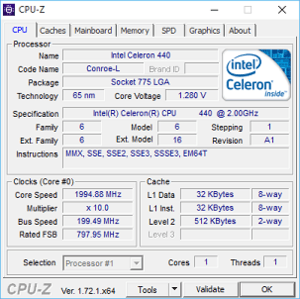CPU-Z
- Not to be comfused with GPU-Z that performs a similar function of detecting GPUs on x86 PCs.
|
| |
|
CPU 1.72.1 under Windows 10 | |
| Developer(s) | CPUID |
|---|---|
| Stable release |
1.78.1
/ November 22, 2016 |
| Operating system | Microsoft Windows, Android |
| Size | 1.62 MB |
| Type | System profiler |
| License | Freeware |
| Website |
www |
CPU-Z is a freeware system profiling and monitoring application for Microsoft Windows and Android that detects the central processing unit, RAM, motherboard chipset, and other hardware features of a modern personal computer, and Android smart phone, and presents the information in one window (in PC version), or by opening the application (in its Android version).
CPU-Z is primarily used to fully detect the CPU and Motherboard hardware of PCs. Without programs like this, a PC user would be less able to fully use the hardware available to them. Linux and Apple OS X have equivalent system hardware information utilities that more or less provide the same level of system detail.
Use in system diagnostics & overclocking
CPU-Z is more in-depth in virtually all areas compared to the tools provided in the Windows OS to identify various hardware components, and thus assists in identifying certain components without the need of opening the case; particularly the core revision and RAM clock rate. Most recently, a graphics card tab has been added.
CPU-Z has an ability to directly detect hardware features, such as the ability to access, read, and display the SPD data from memory modules. The ability to document clock speed makes it a tool for motherboard overclockers, as a way of proving the CPU speeds achieved by various experiments.
See also
External links
- CNET Editors' review (December 2009)
- Softpedia review (October 2006)
- BenchmarkHQ review (2001)
